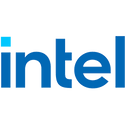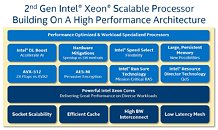Tuesday, April 2nd 2019

Intel Unleashes 56-core Xeon "Cascade Lake" Processor to Preempt 64-core EPYC
Intel late Tuesday made a boat-load of enterprise-relevant product announcements, including the all important update to its Xeon Scalable enterprise processor product-stack, with the addition of the new 56-core Xeon Scalable "Cascade Lake" processor. This chip is believed to be Intel's first response to the upcoming AMD 7 nm EPYC "Rome" processor with 64 cores and a monolithic memory interface. The 56-core "Cascade Lake" is a multi-chip module (MCM) of two 28-core dies, each with a 6-channel DDR4 memory interface, totaling 12-channel for the package. Each of the two 28-core dies are built on the existing 14 nm++ silicon fabrication process, and the IPC of each of the 56 cores are largely unchanged since "Skylake." Intel however, has added several HPC and AI-relevant instruction-sets.
To begin with, Intel introduced DL Boost, which could be a fixed-function hardware matrix multiplier that accelerates building and training of AI deep-learning neural networks. Next up, are hardware mitigation against several speculative execution CPU security vulnerabilities that haunted the computing world since early-2018, including certain variants of "Spectre" and "Meltdown." A hardware fix presents lesser performance impact compared to a software fix in the form of a firmware patch. Intel has added support for Optane Persistent Memory, which is the company's grand vision for what succeeds volatile primary memory such as DRAM. Currently slower than DRAM but faster than SSDs, Optane Persistent Memory is non-volatile, and its contents can be made to survive power-outages. This allows sysadmins to power-down entire servers to scale down with workloads, without worrying about long wait times to restore uptime when waking up those servers. Among the CPU instruction-sets added include AVX-512 and AES-NI.Intel Speed Select is a fresh-spin on a neglected feature most processors have had for decades, allowing administrators to select specific multipliers for CPU cores on the fly, remotely. Not too different from this is Resource Director Technology, which gives you more fine-grained QoS (quality of service) options for specific cores, PIDs, virtual machines, and so on.
Unlike previous models of Xeon Scalable, the first Xeon Scalable "Cascade Lake" processor, the Xeon Platinum 9200, is an FC-BGA package and not socketed. This 5,903-pin BGA package uses a common integrated heatspreader with the two 28-core dies underneath. The two dies talk to each other over a UPI x20 interconnect link on-package, while each die puts out its second UPI x20 link as the package's two x20 links, to scale up to two packages on a single board (112 cores).
Source:
HotHardware
To begin with, Intel introduced DL Boost, which could be a fixed-function hardware matrix multiplier that accelerates building and training of AI deep-learning neural networks. Next up, are hardware mitigation against several speculative execution CPU security vulnerabilities that haunted the computing world since early-2018, including certain variants of "Spectre" and "Meltdown." A hardware fix presents lesser performance impact compared to a software fix in the form of a firmware patch. Intel has added support for Optane Persistent Memory, which is the company's grand vision for what succeeds volatile primary memory such as DRAM. Currently slower than DRAM but faster than SSDs, Optane Persistent Memory is non-volatile, and its contents can be made to survive power-outages. This allows sysadmins to power-down entire servers to scale down with workloads, without worrying about long wait times to restore uptime when waking up those servers. Among the CPU instruction-sets added include AVX-512 and AES-NI.Intel Speed Select is a fresh-spin on a neglected feature most processors have had for decades, allowing administrators to select specific multipliers for CPU cores on the fly, remotely. Not too different from this is Resource Director Technology, which gives you more fine-grained QoS (quality of service) options for specific cores, PIDs, virtual machines, and so on.
Unlike previous models of Xeon Scalable, the first Xeon Scalable "Cascade Lake" processor, the Xeon Platinum 9200, is an FC-BGA package and not socketed. This 5,903-pin BGA package uses a common integrated heatspreader with the two 28-core dies underneath. The two dies talk to each other over a UPI x20 interconnect link on-package, while each die puts out its second UPI x20 link as the package's two x20 links, to scale up to two packages on a single board (112 cores).




88 Comments on Intel Unleashes 56-core Xeon "Cascade Lake" Processor to Preempt 64-core EPYC
BGA hmm not so interesting atleast they should work on TDP for sure.
true that but Intel makes more cores to compete yet with same nm size ??? more power more heat....be like sales down we need more watts :P
Cascade Lake-SP is not a huge improvement over Skylake-SP, but features according to Intel "cache improvements", improvements in clock speed, hardware security mitigations(added late) and a few new instructions for "deep learning" stuff and AVX improvements. Cascade Lake-SP is a fine refinement, but I think everyone is eyeing Ice Lake-SP now, which will be the next large generational jump.I don't know. And why is less serious sites like Wccftech all of a sudden covering the marriage status of tech CEOs? My best guess is it's low effort and attracts attention.Why is this a bad thing? Very few buyers of high-end hardware do it only for gaming, there are a ot of "power users" among the audience here.
I do agree that the quality of the "productivity" part is questionable though.Absolutely.
I also wish that tech writers/journalists in general actually knew about the tech they were writing about, not just people who were interested in tech. This sort of stuff is often obvious whenever mentioning deeper technological stuff. I see the same problem whenever even fairly respected outlets post interviews with engineers/developers; it's glaringly obvious that they don't understand the response from the other party, they don't ask the correct questions, and are not able to see through the BS in the PR talking points that most representatives are instructed to use.
Back to the topic in hand....
In the grand scheme of things such as the support and so on, the server cost might be the last thing on someone's mind. If you want something to do a job, if it's special hardware you need, it's special hardware you buy. You don't buy a single thread based system for multi thread work and expect it to do well.
The prices for these CPUs are massively expensive, but if there's a niche thread of work out there (please excuse the pun) then consumers will have to buy... Wouldn't matter if the competition did offer faster performance in everything else or more cores or whatever, if the other CPU is able to do something twice as fast but cost 4 times the price, people will buy it because of the time saved over the other hardware...
The company I work for is going to be changing to SAP at some point.. I hear that's a bit of an interesting product and program to use.... I wonder what the hardware requirements for that will be...
ERP means enterprise resource planning, which is basically a model of your company. The idea is that one system contains all the data you need: sales, assets, liabilities, inventory, employees, costs, open issues etc.
Lets say your company doesn't have an ERP. You'll have separate systems for different things:
- for sales (who sold what),
- for employees (who came when, who's on medical leave)
- for inventory (what is to be sold)
- for aftersales issues (because the same people who sell are also covering returns or basic repairs)
Keep in mind "a system" could also mean an Excel sheet or hand-written notes...
Imagine the huge cost needed to check efficiency of an employee.
John sold just 3 apples today - he usually sells 17.
Maybe he got sick and went home after lunch? Maybe he was dealing with someone unhappy with bad milk sold yesterday? Maybe there were just 3 apples in the shop? Maybe the power was down for most of the day?
On the other hand, if you have a centralized database (ERP) you can define metrics that can automatically refresh daily (or even live).
Underneath is a normal database, usually Oracle or SQL Server. On top is an interface (either SAP-made or custom) you actually see - it can be good or bad. Those made by SAP seem dated, but I've seen worse custom ones.
The technologically interesting product is SAP HANA, which is a columnar, in-memory database design for analytics. It is hugely fast. It's not a standard yet, but more and more companies buy it.
"In-memory" means the system sucks everything it needs to RAM - in a traditional database disk operations are the biggest cost of queries.
In-memory databases are getting traction now and are the main reason Intel is pushing these Cascade Lake Xeons.
Optane is the game changer, as it was meant to be from the beginning. :)
Ok being a bit off topic but will these manage to secure a better place in market ? I think intel is again planning dirty. Where 5nm fabrication is already reported by TMC and intel is holding the pole of 14nm fabrication is radiculous and just not making sense.
Think about how you're using a desktop. You run programs: browsers, games, maybe even something work-oriented (CAD, video editor or something). You're interested in the total performance and whether there's a single hugely fast core or 20 slower cores doesn't really make a difference as long as performance is on par.
But it does in servers, because here you're dividing a CPU between tasks (systems, VMs). So it might just be that you *need* ~100 cores for whatever reason.
So looking at Skylake offer, you'll need 4 CPUs to get there. 4S racks are very expensive and naturally limited (there's not much space left for drives or accelerators).
With Cascale Lake you can do that with 2 CPUs. 2S racks are cheaper and more flexible.
Also, the potentially high price tag shouldn't be shocking, nor the 400W power draw
9242 and9282 are high frequency CPUs (2.3/3.8 and 2.6/3.8 respectively). They're succeeding (doubling :-)) top of the range 8180, which costs $10k (and TDP is 205W).
But you're saving money on rack, you're saving space and - assuming it's OK for the particular system - you can save A LOT on RAM.
MSRP of Optane 128GB DIMM is slightly under $600. Few stores already offer these and the price is much higher, but still under $1000 (so 5 times less than RAM).
If they launch a 64 GB module for $300, I will consider getting one for my desktop. Amazing.Enterprise customers don't care about fabrication process. They need a tool to get the job done. Intel is giving them these tools.
You probably don't realize how batshit crazy that setup is.
I think if anything I'm more interested in the hardware that runs this software, software for me is dull and rather boring (unless it's finding the cure for cancer etc :D) but hardware I can get my teeth into and want to learn...
Some of the servers we have over in the US for running SAP are complete monsters.. Over a 100 cores, 2Tb of ram, masses of drives.. Unreal bits of kit, certainly a bit more overkill for home usages lol
I take it you've worked with these sorts of software a long time @Solaris17 ? :)
C level sir??